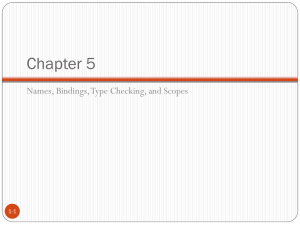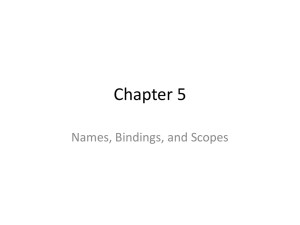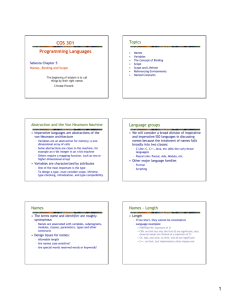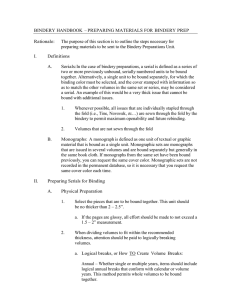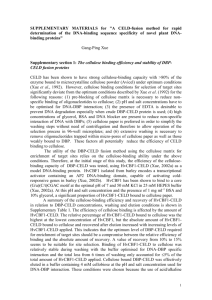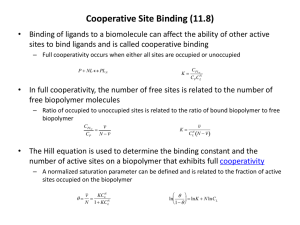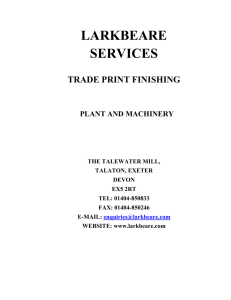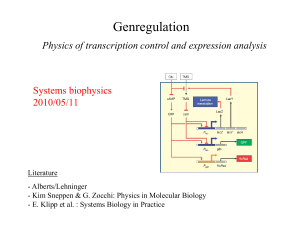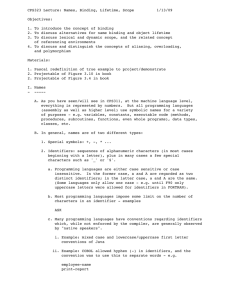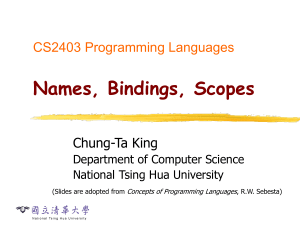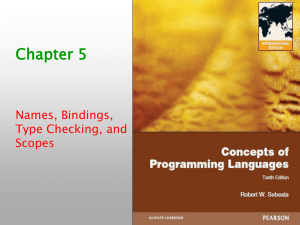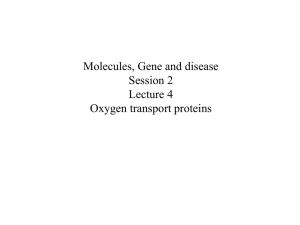Slide 1
advertisement
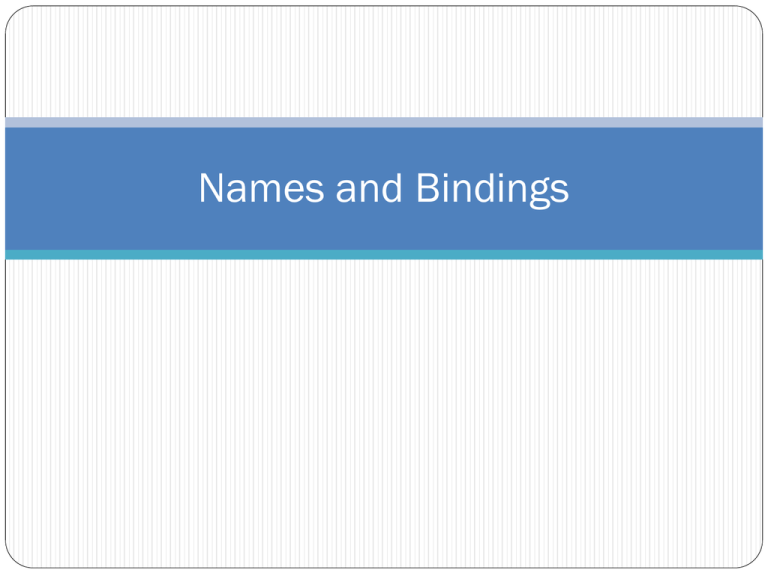
Names and Bindings Names A name is a string of characters used to identify some entity in a program Several design choices are involved even in specifying allowable names Case sensitivity Minimum or maximum length Connectors Treatment of special words Length If too short, names cannot be connotative If too long, extra space required for the symbol table Some examples: FORTRAN I: maximum 6 COBOL: maximum 30 FORTRAN 90 and ANSI C: maximum 31 Ada and Java: no limit, and all are significant C++: technically no limit, but implementers often impose one Names continued Most PLs have the same form for names: a letter followed by a string of letter, digits and underscores Underscores very popular in 1970s and 1980s to represent spaces Replaced in C-based languages by camel notation Prior to Fortran90, names could contain spaces C-based languages are case sensitive Detriment to readability? Writability questionable? Special Words Aid in readability Used to delimit or separate statement clauses Keyword is special only in certain contexts Fortran is the only remaining widely used language whose special words are keywords Reserved words cannot be used as names Cannot be redefined Potentially less confusing, but too many means user has trouble making up new ones Predefined names are between special words and user- defined names Can be redefined Variables Abstraction of a computer memory cell or collection of cells Made up of six attributes: Name Address Value Type Lifetime Scope Address of a Variable The machine memory address with which a variable is associated Can change during the course of execution Different addresses at different times during execution Different addresses at different locations in a program Sometimes referred to as l-value left-hand side of an assignment Multiple variables can have the same address, in which case the variables are called aliases Hindrance to readability Can be created in several ways Variable Type Determines range of values the variable can store Determines the set of operations that are defined for values of that type E.g. int of Java specifies: Range of -2147483648 to 2147483647 Arithmetic operations +, -,*, /,% Variable Value The contents of the memory cell or cells associated with the variable Abstract memory cell has the size required by the variable with which it is associated The value of each simple, non-structured type is considered to occupy a single abstract memory cell E.g. Though a floating point number may occupy 4 physical bytes, the value is thought of as occupying a single abstract memory cell` R-value, since this is what is required when used on the RHS of an assignment statement Binding A binding is an association Attribute and an entity Operation and a symbol The time when the association takes place is the binding time Both binding and binding time are important for semantics of programming languages Possible Binding Times Language design time -- bind operator symbols to operations Language implementation time -- bind floating point type to a representation Compile time -- bind a variable to a type in C or Java Load time -- bind a FORTRAN 77 variable to a memory cell (or a C static variable) Runtime -- bind a nonstatic local variable to a memory cell Java assignment example Count = count + 5; Type of count bound at compile time Set of possible values bound at compiler design time Meaning of + bound at compile time (when types of operands have been determined) Internal representation of literal 5 bound at compiler design time Value of count is bound at execution time with this statement Static vs. Dynamic Bindings Static binding First occurs before run time AND Remains unchanged throughout program execution Dynamic binding First occurs at run time OR Can change in the course of program execution Type Binding Before a variable can be referenced in a program, it must be bound to a data type Two questions: When does type binding take place? How is type specified? Static Type Binding Explicit declaration lists variable names and specifies that they are a particular type Implicit declaration associates variables with types though default conventions First appearance constitutes its implicit declaration Both versions in use today Advantage of implicit: writability Disadvantage: reliability (though less so in Perl) Dynamic Type Binding Type of variable is determined when it is assigned a value Advantage Programming flexibility Disadvantages Reduced reliability Cost Usually implemented in languages with interpreters rather than compilers Type Inference Not by assignment, but by context E.g ML function declaration: Fun circumf(r) = 3.14159 * r * r Floating point (real) type inferred from the constant Fun square(x) = x * x Arithmetic operator * indicates numeric type, so return type and arguments are default numeric type int Allocation and Deallocation Allocation Process by which an available memory cell is taken from a pool of available memory and bound to a variable Deallocation Process of placing a memory cell that has been unbound from a variable back to the pool of available memory Lifetime The time during which the variable is bound to a specific memory location Scalar variables fall into four categories based on their lifetimes: Static Stack-dynamic Explicit heap-dynamic Implict heap-dynamic Static Variables Bound to memory locations before program execution begins Remain bound throughout the program execution Advantages: Efficiency through direct accessing History sensitive subprogram support Disadvantages Reduced flexibility (no recursion, no shared storage) Stack-Dynamic Variables Storage bindings are created when their declaration statements are elaborated, but type is dynamically bound Elaboration refers to the storage allocations and binding process indicated by the declaration Occurs during run-time If scalar, all attributes except address are statically bound Advantages Allows recursion, conserves storage Disadvantages Overhead of allocation and deallocation Subprograms cannot be history sensitive Inefficient references (indirect addressing) Explicit Heap-Dynamic Variables Allocated and deallocated by explicit directives, specified by the programmer, which take effect during execution Referenced only through pointers or references E.g. dynamic objects in C++ (via new and delete), all objects in Java Advantage Provides for dynamic storage management Disadvantage Inefficient and unreliable Implicit Heap-Dynamic Variables Bound to heap storage only when they are assigned values (i.e. assignment statements) E.g. all strings and arrays in Perl and JavaScript Advantage Extremely flexible Disadvantage Inefficient, since all attributes are dynamic Loss of error detection
